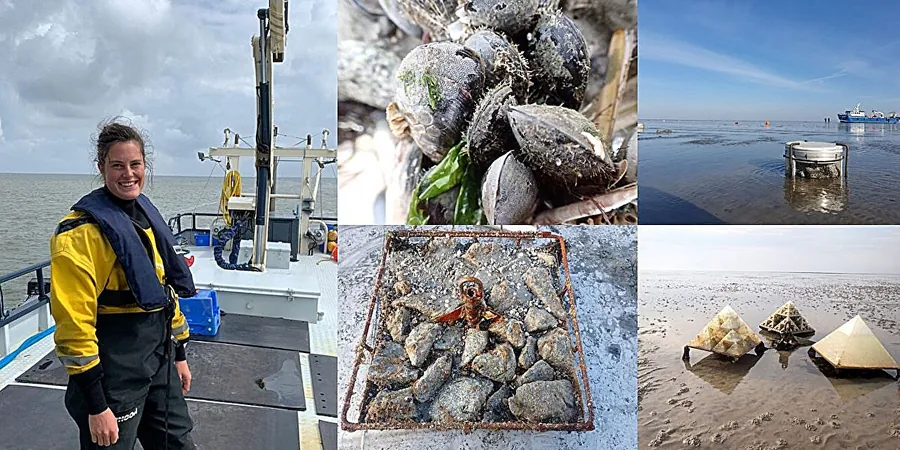
From Nursery to Buffet: The Surprising Fate of Shellfish Reefs
2025-07-02
Author: Ming
The Decline of Shellfish Beds Worldwide
Across the globe, shellfish beds are disappearing at an alarming rate, raising concerns among ecologists and marine biologists. Sterre Witte, a dedicated Ph.D. researcher at the NIOZ Coastal Systems department, has embarked on a mission to unravel the factors that could revive these crucial ecosystems.
Revolutionary Research in the Wadden Sea
Witte's groundbreaking study focused on the submerged channels of the Wadden Sea, where traditional research typically concentrates on mudflats exposed at low tide. She initiated a large-scale field experiment, deploying sixty one-square-meter cages filled with various materials in ten subtidal channels. Her goal? To discover if hard substrates would encourage shellfish settlement in these deeper waters.
The Surprising Results of the Experiment
Among the materials tested were natural options like granite boulders and empty cockle shells, as well as innovative artificial substrates made from biodegradable plastic and coconut fibers. But after a year and a half, the outcome was shocking: not a single mussel bed had formed, and only one solitary oyster was found.
However, there was a silver lining; biodiversity flourished on these hard surfaces. A variety of marine species from anemones to sea slugs began to thrive, even revealing a sea slug believed to be extinct in the area. It became evident that while shellfish weren’t settling, the ecosystem was growing more complex.
Predators Prevail: A Hidden Challenge
Witte’s findings led to a puzzling question: why were mussels and oysters absent? The remnants of Pacific oyster shells suggested that settlement had occurred, but predators like starfish and crabs were also abundant. Instead of fostering a shellfish nursery, the hard substrates had unintentionally become a buffet for these hungry predators.
Caging the Problem: A New Approach
Undeterred, Witte devised a clever solution: small cages with a tiny mesh size to protect juvenile shellfish from being devoured. The results were eye-opening—while the areas outside the cages were nearly devoid of shellfish, high densities thrived within. This confirmed that predation plays a pivotal role in shellfish settlement in deeper waters.
Finding the Real Solution for Shellfish Restoration
Ultimately, Witte concluded that increasing the complexity of the substrates could offer the shelter that juvenile shellfish desperately need.
"Think of it like crumpling a smooth sheet of paper," she explains. "A more intricate surface allows juvenile shellfish to evade predators." In her final experiment, Witte utilized 3D-printed pyramids with varying surface complexities, promoting the settlement of both mussels and flat oysters, the latter of which are functionally extinct in the Netherlands.
A Vision for the Future
However, Witte acknowledges that simply inundating the Wadden Sea with these structures isn't a practical solution. Instead, she advocates for nature managers to integrate complex substrates in their efforts to restore shellfish reefs. Currently a postdoctoral researcher at the Danish Technical University, Witte admires Denmark's ambition in large-scale ecological restoration, including the construction of significant boulder reefs and mussel beds.
With Witte’s pioneering research, a clearer path toward revitalizing shellfish populations emerges, combining innovation with environmental stewardship.


 Brasil (PT)
Brasil (PT)
 Canada (EN)
Canada (EN)
 Chile (ES)
Chile (ES)
 Česko (CS)
Česko (CS)
 대한민국 (KO)
대한민국 (KO)
 España (ES)
España (ES)
 France (FR)
France (FR)
 Hong Kong (EN)
Hong Kong (EN)
 Italia (IT)
Italia (IT)
 日本 (JA)
日本 (JA)
 Magyarország (HU)
Magyarország (HU)
 Norge (NO)
Norge (NO)
 Polska (PL)
Polska (PL)
 Schweiz (DE)
Schweiz (DE)
 Singapore (EN)
Singapore (EN)
 Sverige (SV)
Sverige (SV)
 Suomi (FI)
Suomi (FI)
 Türkiye (TR)
Türkiye (TR)
 الإمارات العربية المتحدة (AR)
الإمارات العربية المتحدة (AR)